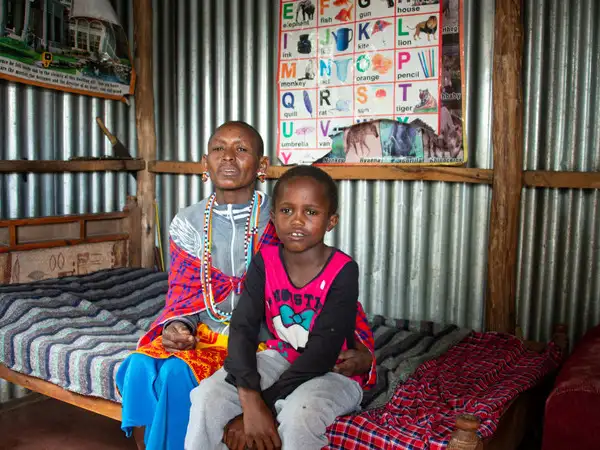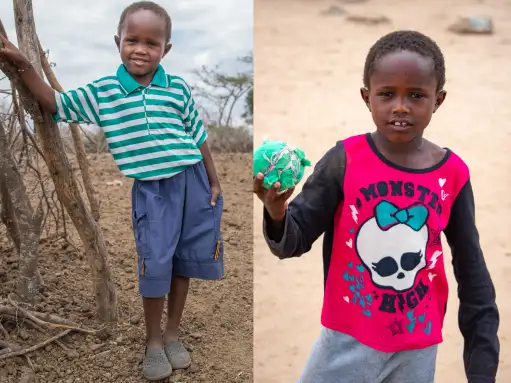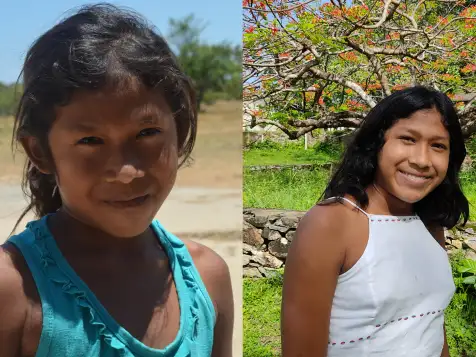Human rights defenders
We're urging the government to introduce a new law that will hold UK companies to account when their activities lead to human rights and environmental abuses.


“We lost most of our animals because of the drought” says Noomirosho, Olomaina's mother. Photo credit: Alex Kameru
Maria, Denislania and Olomaina live in Bangladesh, Brazil and Kenya - three of the countries most affected by the climate crisis in the world.
We first met them as babies in 2009, when their stories were captured by the Observer newspaper. We asked what impact the climate crisis might have on their future and revisited the children six years later in 2015.
Before this year's COP26 climate talks in Glasgow, we caught up with them again as they become teenagers to see how the climate crisis is still affecting their lives and their families.
Find out how we took action on the climate crisis in 2021


Maria from Bangladesh - in 2009, 2015 and 2021
““I want to become a teacher and spread the light of education to everyone"”
When we first met the Mallik family from Barguna District in Bangladesh they had been badly affected by the catastrophic cyclones Sidr in 2007 and Aila in 2009, and were in tremendous financial hardships.
13-year-old Maria is still in school, largely thanks to personal sacrifices made by her family. Maria’s 24-year-old sister, Rahima, spent 12 years from the age of 11 working in a garment factory in Dhaka, and her 14-year-old brother, Saidul, is earning less than £1.40 a day working on cargo ships transporting unpackaged goods such as grain, sand, coal, and cement.
Climate change is making the water level in the Bay of Bengal and the Payra river just two miles from their home rise every year.
“The impact of the changing climate is weakening me mentally and financially,” says Maria’s father Tayab, who is a rickshaw driver. “There are frequent tidal floods, cyclones and heavy rains that damage our house.”
“The surrounding crops and plants are getting damaged. The saline water from the sea causes extensive damage to the crops and contaminates the water in the nearby well. Fish are also affected,” adds Tayab.
Being so close to the Payra river and on low-lying land means their home is frequently flooded. “Our house was very torn and broken, and rainwater used to fall through the roof,” adds Maria.
Maria has also noticed the changing climate: “From April to September there is a lot of rain. People really suffer at this time.”
In addition to the financial hardships it has brought the family, the climate crisis has impacted their physical wellbeing.
“The sudden rise in temperature causes me to have heat stroke and my breathing has become increasingly difficult,” says Tayab. “My son and daughters suffer from frequent fever, diarrhoea and stomach aches, which is disrupting their everyday life. Extreme temperatures are decreasing our stamina and make it harder to work.”
Despite the problems the family face, Maria is a happy and positive child. “I want to become a teacher and spread the light of education to everyone,” she says.


Olomaina from Kenya - in 2009, 2015 and 2021
“"Climate change is making life difficult for us, especially the lack of water"”
Olomaina means ‘blessing’ in Masai – and back in 2009 his mother certainly hoped that the birth of her son would bring hope and prosperity to their family.
But 12 years on and with eight growing children to provide for, the family find themselves in difficult times. In 2009 the family had 284 livestock but they’ve now lost almost everything.
“We lost most of our animals because of the drought. Currently we have only one cow and that one is from a friend,” says his mother, Noomirisho. For Masai people owning cattle is a crucial part of their social status.
Droughts were increasing in severity when we first met Olomaina and his family, and sadly this continues.
“I have noticed some changes to the climate, such as the drought,” explains Noomirisho. “We had some rains in January and February, which is not normal. We normally have rains in April and May. And even now the rains for June have been fairly minimal. Not like the previous seasons when we used to have heavy and long rains. Even if the rains come it rains for a very short while and within no time the grass is dry, the livestock die and we find ourselves going back to poverty.”
It is hard for Noomirisho to see the situation improving. “Life will be more difficult, and we fear we will have more challenges. Our hopes are with God that maybe something good will happen.”
Noomirisho sees education as the way out of poverty for her family: “The children weren’t at school, but we sold our house to use the money to educate our children,” she says. “I want my son [Olomaina] to become a lawyer. I want him to represent the community.”
Noomirisho has a message for leaders meeting this November: “Climate change is making life difficult for us, especially the lack of water. If the leaders can make water available or bring it nearer to the people that would be good. Also, leaders should look for ways to help with children’s education. I fear it is becoming a challenge for poor families.”


Denislania from Brazil - in 2009, 2015 and 2021
In 2009, the year Denislania was born, Brazil’s Supreme Court ruled in favour of the indigenous Macuxi people in their battle against farmers who wanted to turn the region’s marshlands – where local indigenous people hunt and fish – into rice plantations.
“I like the nature where I live,” says Denislania, now 13 years old. “I like to swim in the Surumu river and walk in the Serra do Mararí hills.”
““They need to preserve the planet, to look after it.””
However, the natural Amazonian savannah land that Denislania and the Macuxi people depend upon is under threat, including from the changing climate. Droughts and extreme temperatures during summer in the Surumu region have meant that ‘good fires’ – those used by indigenous communities on a small scale and in a controlled way to stimulate agricultural production – can easily spread out of control.
Her mother, Elisa, is a voluntary community firefighter helping to preserve their land and ensure it doesn’t burn. “I feel proud that I'm here...fighting fires, I'm a warrior woman!” she says. “Many people say: ‘being a firefighter is only for men’. I don't think so,” says Elisa.
Support CAFOD’s Climate Crisis Appeal
In 2015, Elisa was very concerned about the changing climate. In 2021, she says the weather patterns have been more stable in her community - however, in other parts of Roraima state and across the Brazilian Amazon, many indigenous communities have been hit by the worst flooding since records began 100 years ago.
Covid-19 has also affected the community, and in early 2021 oxygen tanks ran empty in remote municipal health centres and hospitals across the Amazon region. “It was serious here,” explains Elisa. “We lost our relatives, elders and teachers in the community.”
Since we last spoke to Denislania and her mother Elisa, proposed legislation in Brazil is posing huge threats to the lives and ancestral lands of thousands of indigenous communities. If this legislation passes in the Brazilian Congress, both indigenous people and the environment will be negatively impacted for future generations.
As world leaders gather for COP26 in Glasgow, Denislania - who hopes to become a lawyer – has a message for them: “They need to preserve the planet, to look after it.”
We're urging the government to introduce a new law that will hold UK companies to account when their activities lead to human rights and environmental abuses.